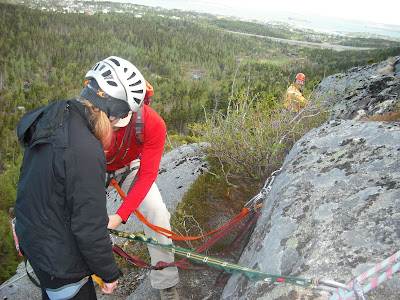
I read about a new anchoring system called the
equalette in John Long's latest
edition of Climbing Anchors. It is an very different book than the previous edition. Much more involved with the physics of anchor building. It is not just pictures of what to do and what not to do.
In this book he described an equalette and discussed how it is better than a cordalette. I loved my cordalette so I just had to check this thing out. Well, here it is.
It is any piece cordalette or webbing. The center is found and 2 overhand knots are tied about 6 inches apart. This provides 2 limbs between the knots and a biner is clipped each one separately and the rope is threaded thru both biners. If either side fails, extension is limited by the overhand knots. If either limb between knots fails, the other is there for backup. SO it is equalized, redundant and no extension. What makes it better? An equalette can accommodate 2 to 4 pieces and it distributes the load more evenly to all pieces.
A cordalette require 3 pieces, and is used to connect all three with an overhand knot at the power point. Rarely things are perfectly equalized. This causes one piece to carry more load than others. Even if it is well equalized, the anchor is unidirectional. If you climb out of the intended direction of fall, the load does not distribute equally.
The power point of the equalette acts like a sliding X, it automatically equalizes to the direction of pull. Unlike the sliding X, extension is minimized by the overhand knots. It can be used with 2, 3 or 4 pieces. With 2 pieces, figure 8's on a bite are used to determine where the power point is placed.

With 3 or 4 pieces, the highest piece is tied with a figure 8. Then each of the three remaining limbs are tied to the other pieces with clove hitches. They are adjusted so the power point hangs in the middle. When loaded, the weight is evenly distributed over all placement (unless your adjustments are really messed up).
In his book, John Long states that once you are used to the system, it is faster to set-up and tear down, neater and easier to check. If you require only one biner (ie for Gri Gri), you can place a biner thru both biners already hanging or rig a single biner as for a sliding X.






































